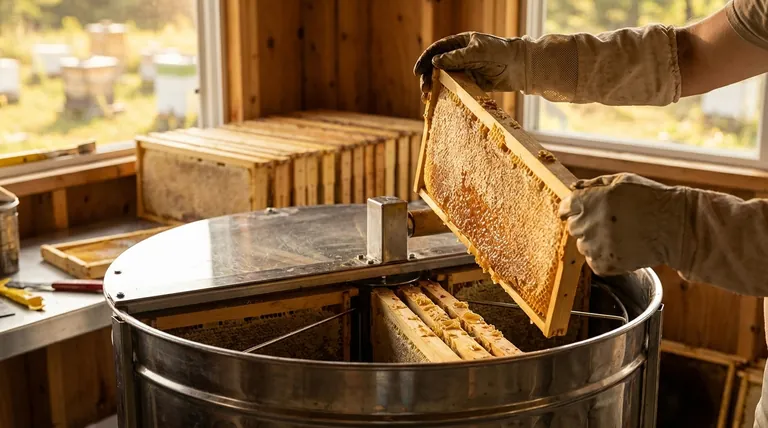The fundamental reason Langstroth and Dadant beehive frames are popular is their design directly enables modern, efficient honey extraction. Their standardized dimensions ensure they fit virtually any centrifugal extractor, while their removable nature allows for a harvest that is both productive for the beekeeper and minimally disruptive to the bees.
The choice of these frames isn't just about convenience; it represents a core principle of modern beekeeping. This system prioritizes the preservation of the honeycomb, which saves the bees immense energy and dramatically increases a hive's potential for honey production.

The Foundation of Modern Extraction: Standardization
Before standardized hives, honey harvesting was often a destructive process. Hives like traditional skeps required the beekeeper to destroy the comb to get the honey, setting the colony back significantly.
Universal Fit for Equipment
The primary advantage of standardization is interoperability. A Langstroth or Dadant frame from any manufacturer will fit into a standard honey extractor.
This frees beekeepers from being locked into a single brand of equipment. It creates a competitive and accessible market for essential tools.
Predictability and Scalability
Standard dimensions create a predictable workflow. Beekeepers know exactly what to expect when inspecting a hive, moving frames, or preparing for extraction.
This system allows an apiarist to manage one hive or hundreds using the same repeatable process and equipment, making it the foundation for any commercial operation.
How Removable Frames Revolutionized Harvesting
The concept of a removable frame, pioneered by L.L. Langstroth, is the true innovation that makes modern beekeeping possible. It works in perfect harmony with the honey extractor.
The Principle of Centrifugal Force
A honey extractor is a machine that spins the frames at high speed. This centrifugal force slings the honey out of the wax cells and against the wall of the extractor drum, where it can be collected.
Enabling Non-Destructive Extraction
The wooden frame provides the crucial structural support for the wax comb. Without it, the delicate comb would shatter under the intense force of the spinning extractor.
This allows beekeepers to extract the honey while leaving the intricate beeswax structure completely intact.
The Benefit to the Hive: Reusable Comb
Bees expend a tremendous amount of energy and resources to produce wax and build their comb. It's estimated bees consume 6-8 pounds of honey to produce just one pound of wax.
By returning the empty, undamaged comb to the hive after extraction, the bees can immediately begin refilling it with honey. This saves them weeks of work and leads to a healthier colony and significantly higher honey yields.
Understanding the Practical Considerations
While this system is dominant, it's important to recognize the context in which it operates. Understanding the trade-offs provides a complete picture.
The Rigidity of the System
The greatest strength of standardization is also its main constraint. Beekeepers using this system have less flexibility for experimental hive shapes or frame designs compared to those using alternatives like Top Bar hives.
The Initial Equipment Investment
While efficient in the long run, the initial purchase of a standard hive and a compatible extractor represents a notable financial commitment for a new beekeeper.
Extraction is Still a Skill
Even with the right equipment, proper extraction requires care. Frames must be uncapped correctly, and the extractor must be loaded and spun in a balanced way to avoid damaging the comb or the machine.
Making the Right Choice for Your Goal
Your choice of hive system should align directly with what you want to achieve in beekeeping.
- If your primary focus is maximizing honey production: The Langstroth/Dadant system is the undisputed standard due to its efficiency and preservation of drawn comb.
- If your primary focus is scalability and operational simplicity: The universal compatibility of standardized frames is essential for managing multiple hives effectively.
- If your primary focus is a more natural or less-interventive approach: You might explore other hive types but must accept you will forego compatibility with standard centrifugal extractors.
Ultimately, the synergy between the standardized frame and the honey extractor is what transformed beekeeping from a simple craft into a sustainable agricultural practice.
Summary Table:
| Key Feature | Benefit for Beekeepers |
|---|---|
| Standardized Dimensions | Fits virtually any centrifugal honey extractor on the market. |
| Removable Frame Design | Enables non-destructive harvesting, preserving the beeswax comb. |
| Reusable Comb | Saves bees weeks of work, leading to healthier colonies and higher honey production. |
| Scalability | Allows for predictable, repeatable processes from one hive to hundreds. |
Ready to scale your beekeeping operation with the right equipment?
HONESTBEE supplies high-quality, standardized Langstroth and Dadant beehive frames and compatible honey extractors to commercial apiaries and beekeeping equipment distributors. Our wholesale-focused operations ensure you get the durable, interoperable equipment you need to maximize honey yield and operational efficiency.
Contact our team today to discuss your bulk supply needs and how we can support your growth.
Visual Guide

Related Products
- Mini Desktop Bee Hive Frame Forming Making Machine
- Professional In-Hive Bee Feeder HONESTBEE Frame for Beekeeping
- Plastic Bee Frame Beekeeping Hive Frames for Wholesale
- Professional Bee Frame Wiring Tool with Integrated Tensioning System by HONESTBEE
- Assembled Wooden Bee Frames with Beeswax Foundation Ready to Use by HONESTBEE
People Also Ask
- How are Langstroth beehive frames assembled? A Step-by-Step Guide for a Durable Hive
- What are the qualities of the bee frame forming machine? Durable, Efficient, and Built to Last
- What is the difference between assembled and unassembled beehive frames? Save Time or Money for Your Hive
- What is an automatic sidebar forming machine? Automate High-Volume Beehive Frame Production
- What are the advantages of using the Beehive Frame Making Machine? Boost Apiary Efficiency & Self-Sufficiency



















